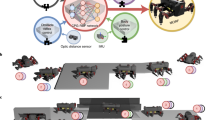Abstract
Locomotion in animals is characterized as a stable, rhythmic behavior which at the same time is flexible and extremely adaptive. Many motor control approaches have taken considerable steps taking insights from biology. As one example, the Walknet approach for six-legged robots realizes a decentralized and modular structure that reflects insights from walking in stick insects. While this approach can deal with a variety of disturbances during locomotion, it is still limited dealing with novel and particular challenging walking situations. This has lead to a cognitive expansion that allows to test behaviors outside their original context and search for a solution in a form of internal simulation. What is still missing in this approach is the variation of lower level motor primitives themselves to cope with difficult situation and any form of learning. Here, we propose how this biologically-inspired approach can be extended in order to include a form of trial-and-error learning. The realization is currently underway and is based on a more broad formulation as a hierarchical reinforcement learning problem. Importantly, the structure of the hierarchy follows the decentralized organization taken from insects.
Access this chapter
Tax calculation will be finalised at checkout
Purchases are for personal use only
Similar content being viewed by others
References
Brockman, G., Cheung, V., Pettersson, L., Schneider, J., Schulman, J., Tang, J., Zaremba, W.: Openai gym. arXiv preprint arXiv:1606.01540 (2016)
Cruse, H.: A quantitative model of walking incorporating central and peripheral influences. i. the control of the individual leg. Biol. Cybern. 37, 131–136 (1980)
Cully, A., Clune, J., Tarapore, D., Mouret, J.B.: Robots that can adapt like animals. Nature 521(7553), 503–507 (2015). https://doi.org/10.1038/nature14422
Florensa, C., Duan, Y., Abbeel, P.: Stochastic neural networks for hierarchical reinforcement learning. CoRR abs/1704.03012 (2017). http://arxiv.org/abs/1704.03012
Frans, K., Ho, J., Chen, X., Abbeel, P., Schulman, J.: Meta learning shared hierarchies. CoRR abs/1710.09767 (2017). http://arxiv.org/abs/1710.09767
Heess, N., Wayne, G., Tassa, Y., Lillicrap, T.P., Riedmiller, M.A., Silver, D.: Learning and transfer of modulated locomotor controllers. CoRR abs/1610.05182 (2016). http://arxiv.org/abs/1610.05182
Hoinville, T., Schilling, M., Cruse, H.: Control of rhythmic behavior: central and peripheral influences to pattern generation (2015)
Holmes, P., Full, R.J., Koditschek, D., Guckenheimer, J.: The dynamics of legged locomotion: models, analyses, and challenges. SIAM Rev. 48(2), 207–304 (2006)
Ijspeert, A.J.: Central pattern generators for locomotion control in animals and robots: a review. Neural Netw. 21(4), 642–653 (2008)
Ijspeert, A.J., Crespi, A., Ryczko, D., Cabelguen, J.M.: From swimming to walking with a salamander robot driven by a spinal cord model. Science 315(5817), 1416–1420 (2007)
Porta, J.M., Celaya, E.: Efficient gait generation using reinforcement learning. In: Proceedings of 4th International Conference on Climbing and Walking Robots (CLAWAR 2001), pp. 411–418 (2001)
Kidzinski, L., Mohanty, S.P., Ong, C.F., Huang, Z., Zhou, S., Pechenko, A., Stelmaszczyk, A., Jarosik, P., Pavlov, M., Kolesnikov, S., Plis, S.M., Chen, Z., Zhang, Z., Chen, J., Shi, J., Zheng, Z., Yuan, C., Lin, Z., Michalewski, H., Milos, P., Osinski, B., Melnik, A., Schilling, M., Ritter, H., Carroll, S.F., Hicks, J.L., Levine, S., Salathé, M., Delp, S.L.: Learning to run challenge solutions: Adapting reinforcement learning methods for neuromusculoskeletal environments. CoRR abs/1804.00361 (2018). http://arxiv.org/abs/1804.00361
Lillicrap, T.P., Hunt, J.J., Pritzel, A., Heess, N., Erez, T., Tassa, Y., Silver, D., Wierstra, D.: Continuous control with deep reinforcement learning. arXiv preprint arXiv:1509.02971 (2015)
McFarland, D., Bösser, T.: Intelligent Behavior in Animals and Robots. MIT Press, Cambridge (1993)
Mnih, V., Kavukcuoglu, K., Silver, D., Rusu, A.A., Veness, J., Bellemare, M.G., Graves, A., Riedmiller, M., Fidjeland, A.K., Ostrovski, G.: Human-level control through deep reinforcement learning. Nature 518(7540), 529–533 (2015)
Nishimoto, R., Tani, J.: Development of hierarchical structures for actions and motor imagery: a constructivist view from synthetic neuro-robotics study. Psychol. Res. 73, 545–558 (2009)
Schilling, M., Cruse, H.: What’s next: Recruitment of a grounded predictive body model for planning a robot’s actions. Front. Psychol. 3(383) (2012). https://doi.org/10.3389/fpsyg.2012.00383
Schilling, M., Cruse, H.: Reacog, a minimal cognitive controller based on recruitment of reactive systems. Front. Neurorobot. 11, 3 (2017). https://doi.org/10.3389/fnbot.2017.00003
Schilling, M., Cruse, H., Arena, P.: Hexapod walking: an expansion to walknet dealing with leg amputations and force oscillations. Biol. Cybern. 96(3), 323–340 (2007)
Schilling, M., Hoinville, T., Schmitz, J., Cruse, H.: Walknet, a bio-inspired controller for hexapod walking. Biol. Cybern. 107(4), 397–419 (2013)
Schilling, M., Paskarbeit, J., Hoinville, T., Hüffmeier, A., Schneider, A., Schmitz, J., Cruse, H.: A hexapod walker using a heterarchical architecture for action selection. Front. Comput. Neurosci. 7, 126 (2013). https://doi.org/10.3389/fncom.2013.00126
Schilling, M., Paskarbeit, J., Schmitz, J., Schneider, A., Cruse, H.: Grounding an internal body model of a hexapod walker - control of curve walking in a biological inspired robot–control of curve walking in a biological inspired robot. In: Proceedings of IEEE/RSJ International Conference on Intelligent Robots and Systems, IROS 2012, pp. 2762–2768 (2012)
Acknowledgments
This research/work was supported by the Cluster of Excellence Cognitive Interaction Technology ‘CITEC’ (EXC 277) at Bielefeld University, which is funded by the German Research Foundation (DFG).
Author information
Authors and Affiliations
Corresponding author
Editor information
Editors and Affiliations
Rights and permissions
Copyright information
© 2019 Springer Nature Switzerland AG
About this paper
Cite this paper
Schilling, M., Melnik, A. (2019). An Approach to Hierarchical Deep Reinforcement Learning for a Decentralized Walking Control Architecture. In: Samsonovich, A. (eds) Biologically Inspired Cognitive Architectures 2018. BICA 2018. Advances in Intelligent Systems and Computing, vol 848. Springer, Cham. https://doi.org/10.1007/978-3-319-99316-4_36
Download citation
DOI: https://doi.org/10.1007/978-3-319-99316-4_36
Published:
Publisher Name: Springer, Cham
Print ISBN: 978-3-319-99315-7
Online ISBN: 978-3-319-99316-4
eBook Packages: Intelligent Technologies and RoboticsIntelligent Technologies and Robotics (R0)




